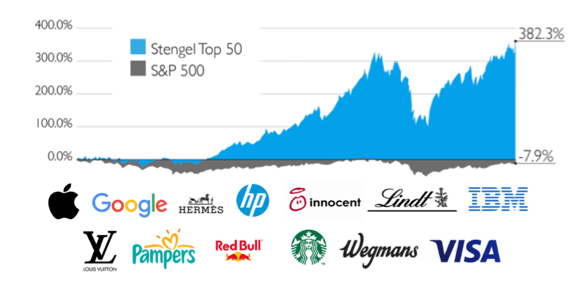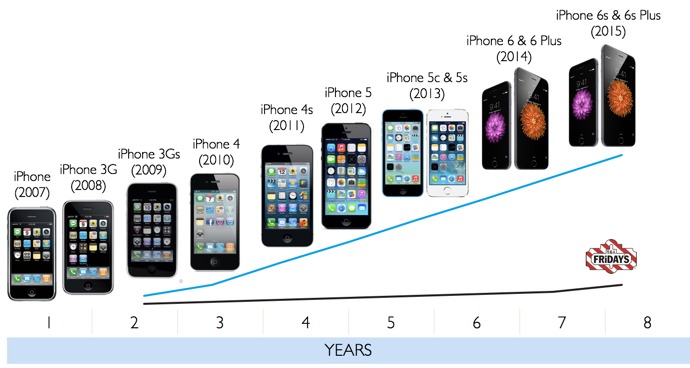With today’s disruptive technologies and evermore competitive forces factoring into the planning calculus for modern restaurant success, brand leaders are pressed even harder to continuously adapt to stay relevant, or die off.
Most companies know that a brand is not a “one and done” investment, rather an ever-evolving demonstration of present-day relevance; while at once honoring the history of the brand and simultaneously steering it safely through the changing tides to its imagined future state.
Branding used to just include the corporate identity, packaging, interior and exterior designs, and some reflections in training and company culture. But in this day in age, oftentimes the physical and digital representations of the brand are out of alignment, as there are more channels that brand communications need to be monitored than ever before.
We’re now living in a world where branding means having an olfactory logo (and not just a signature dish, but a signature scent) and all sorts of other new mandatory knowledge like sensory branding and neuromarketing.
QUESTIONS FOR BRAND IDENTITY CRISIS SELF-DIAGNOSIS
- Does your brand have a relevant role in today’s society (and where it is headed)?
- Do you or members of your team feel insecure about the presentation, menu, marketing, or messaging of your brand?
- Are you worried about activist bloggers or activist investors attacking based on brand-vulnerability?
- Is there clarity around where the company is headed?
- Are there instances of consumer confusion between your brand and a competitor (not in terms of logos and corporate identity, but regarding similarity of product offerings and competitive proposition)?
- Is your brand pigeonholed as something the market has outgrown?
- Is there uncertainty among stakeholders and shareholders about the direction the brand is headed, and the strength of its competitive proposition?
- Are you uncertain about how relevant your brand will be in the context of emerging consumer trends and behaviors?
So, how did you do? If your executive team answered “no” to several of the questions above, congratulations – you have successfully self-diagnosed a very common problem faced in the restaurant industry.
BEING OUTSTRIPPED BY THE PACE OF CHANGE
Along with all of the digital channel explosions, the evolution of consumer trends means that companies have to react on faster cycles just to keep up. Most restaurants would typically remodel every 5 – 7 years, drastically outpaced by the change in technologies we are now accustomed to.
With this constant acceleration of change, the more frequently brands need to be recalibrated or adjusted to keep from falling behind. Think of it as the equivalent of driving a steamroller versus an airplane — the faster-moving plane is more difficult to manage and keep consistently on course, and that’s essentially what’s happening to restaurant companies all over the world. Some troubled chains realized too late that the pace of change outside the business was happening faster than change inside the business and it cost them buckets of cash and market share.
 WELL-ESTABLISHED BRANDS AREN’T IMMUNE; THEY ARE MOST SUSCEPTIBLE
WELL-ESTABLISHED BRANDS AREN’T IMMUNE; THEY ARE MOST SUSCEPTIBLE
Even big brands going through identity crises and have cycled in and out of relevance over the years. Just look at the evolution of McDonald’s and Coca Cola, often considered some of the strongest brands in history. McDonald’s is fighting and finding its way back to relevance again today but they’ve been here many times before.





ALIGNING WITH THE TRENDS
Increasingly, purpose-oriented companies have demonstrated that such a focus is good not only for their company and causes it supports, but also delivers tremendous value to shareholders. Of 50,000 brands studied, the 50 fastest-growing, in terms of value (referred to as the “Stengel Top 50”), were purpose-driven and purpose-oriented.

This is not just the flavor-of-the-day in brand strategy; Millennials are arguably the most important demographic to the restaurant industry, and they are more cause-conscious than any generation before them.
Other trends to take into consideration when evaluating the future for a brand include:
- Social/Cultural Trends – increasing numbers of women in the workforce, increase in work hours, etc.
- Economic Trends – increases/decreases in disposable incomes, currency fluctuations, etc.
- Demographic Trends – influence of Millennials, number of births, etc.
- Political Trends – new business regulations, public interest groups, etc.
- Technological Trends – mobile payment increases, self-order technologies, etc.
- Marketing Trends – rise of geo-social technologies, in-bound versus out-bound approaches, etc.
- Supply Chain Trends – increasing/decreasing ingredient and commodity costs, importance of product traceability, etc.
- Consumer Dining Trends – focus on local/organic, sense of place and season, etc.
- And more restaurant industry trends.
GETTING STARTED – ESTABLISHING A BRAND CONSTITUTION
 Running a company can be paralleled to running your own country. Using this analogy, what kind of government would be the closest representation of how you want your company to run? And what would be included in your company’s constitution – the set of fundamental principles, values, virtues, and vision that can guide all other decisions made within the organization?
Running a company can be paralleled to running your own country. Using this analogy, what kind of government would be the closest representation of how you want your company to run? And what would be included in your company’s constitution – the set of fundamental principles, values, virtues, and vision that can guide all other decisions made within the organization?
If every executive in the company was sitting around a table and was asked to write down the story of the brand, would everyone’s answer come back the same?
We all generally agree that the best marketing is word of mouth. But that leaves us wondering – if the C-suite can’t communicate the story, how could it possibly be expected that the crew could? Some think the crew does not have to deliver on the branding, but these employees are some of the most important ambassadors of the brand. If employees at the unit- and line-level are tasked with delivering this story, but aren’t able to communicate the brand story in a concise, compelling, and consistent way, the impact of the brand is diluted at these customer touchpoints.
The natural inclination might be to think that these things are covered during training, or documented in company standard operating procedures (SOP). But consider this through the lens of the brand. Just delivering on the technical requirements of the job description – what we typically think of as SOP, the technical requirements, tasks, checklists, and basic guest service norms, does not sufficiently address the aspirational aims of the brand messaging nor reflect a true enculturation and internalization of the brand for company employees.
AS WITH ANY DIAGNOSIS …
It’s a lot easier to diagnose drawing conclusions from obvious symptoms than it is to prescribe and carry through on an expensive and laborious treatment plan. It is okay to acknowledge a problem and short-comings (advised, in fact, if acted on) and you can also take comfort in knowing that almost all companies go through an identity crisis at some point (the successful ones, at least).
The harder part of all of this is: what do you do now? How do you fix it and get back on track, aligning the history and DNA of the brand with its future aims and aspirations? Oftentimes, this requires objective, external insights and guidance – helping to understand the trends, where the consumer is headed, ever-changing market dynamics, accurately predicting those factors and competitive forces – to help a company navigate through these changes.
After diagnosing whether or not your brand is having an identity crisis, here are some questions to prompt conversations to help resolve it and lay the foundation for a refreshed brand (also see: How to Refresh a Stale Restaurant Brand).
IDENTIFYING NEEDS TO ADDRESS WHEN REBRANDING
- Is it clear that a rebrand could enable competitive leapfrogging?
- Is our brand out of step with current trends?
- Are there inconsistencies with how our brand is portrayed or presented across the system?
- What problems are we planning to address with rebranding?
DEFINING PURPOSE, PROMISES & BRAND IDENTITY
- Does our brand have a clear positioning strategy?
- What about our brand provides distinct differentiation?
- What promises have we documented for our key stakeholders (customers, employees, shareholders, etc.)?
- If every executive in the company were in a room together and asked to write down the company’s purpose, how many responses would be the same?
ALIGNING MESSAGING & BRAND RESPRESENTATION
- Could our messaging just as easily be used by competitors? Could any of our competitors’ logos be swapped out with ours, and the message still be applicable?
- Have our major brand touchpoints become outdated?
- Does our brand messaging translate well into new markets we plan to expand into?
- Are we consistent across all physical and digital representations of our brand?
IDENTIFYING CONSUMER TRENDS & FUTURE ALIGNMENT
- Have we integrated sensory branding (i.e., an olfactory logo) into our brand?
- How well is our brand integrated into our design? Our training materials? Our product?
- How does our brand align with emerging consumer trends?
![]()
Aaron Allen & Associates is a leading global restaurant consultancy specializing in holistic and integrated brand strategy. As a part of our work we facilitate and lead rebranding initiatives for executive teams looking to honor their brand history while reimagining and strengthening its future. Click here more information on how we can further enrich and enable your brand.


 WELL-ESTABLISHED BRANDS AREN’T IMMUNE; THEY ARE MOST SUSCEPTIBLE
WELL-ESTABLISHED BRANDS AREN’T IMMUNE; THEY ARE MOST SUSCEPTIBLE